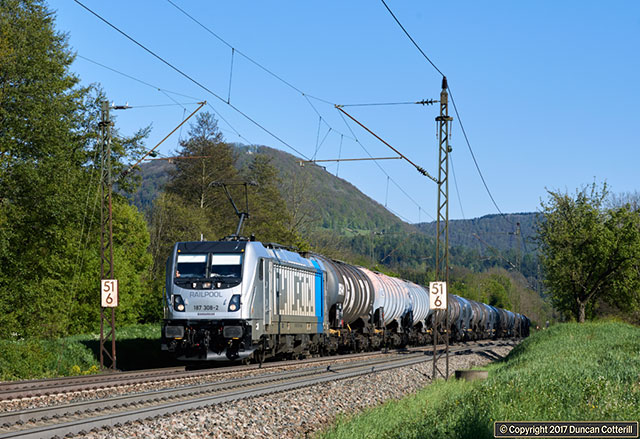BAD WEATHER IN BADEN WÜRTTEMBERG
dodging the cloud and rain in the south-west
Germany - 27 April to 10 May 2017 - Report by Duncan Cotterill
INTRODUCTION
A two week trip to southern Germany in late April and early May 2017. There was a new class to photograph on a line I knew well, a busy scenic line that had been explored by train and on Google Earth but not yet photographed and a last chance to visit a busy diesel worked route before the classic locos are replaced by bland new traction. As the title suggests it wasn’t as easy a trip as it should have been.This page contains the main report summarising the trip. Detailed daily observations can be found here.
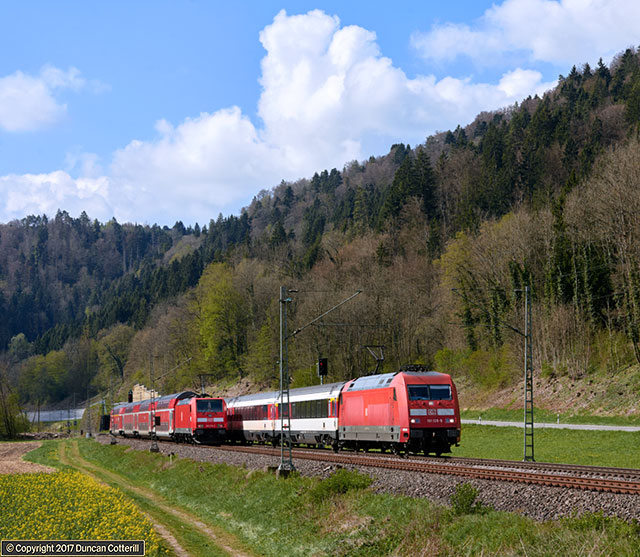
Grünholz Cross
101.129 wheeled IC 182, the 08:35 InterCity passenger from Zürich HB to Stuttgart Hbf, through Grünholz on 29 April 2017. In the loop, 146.214 waited to propel RE 19033, the 09:18 from Stuttgart, southwards towards Singen.Timings had changed since my previous visit resulting in an IC crossing a loco worked RE at Grünholz every hour, northbound and southbound services alternating.
Grünholz is around halfway between Sulz and Oberndorf and is one of six passing loops in the 40km between Horb and Rottweil. Sulz and Oberndorf are stations but the other four, Neckarhausen, Grünholz, Epfendorf and Talhausen, have no passenger facilities.
KBS 740 STUTTGART – SINGEN (GÄUBAHN)
27 Apr – 02 MayStuttgart – Singen had been one of my favourite lines earlier in the decade, when InterCity trains were worked by an eclectic mix of Classes 115, 120 and 181 and far fewer of the ubiquitous and unattractive Class 101s than there were meant to be. More recently 101s became the norm and my interest waned. This year Class 111s have taken over most Stuttgart – Singen RegioExpress services from the bland class 146.2s, providing enough of an excuse for another visit.
Passenger Services
The Gäubahn hosts a number of different passenger services but the most interesting these days are the two-hourly Stuttgart – Singen REs, now mainly worked by Class 111s on 4-coach double-deck push-pull sets. In previous years these trains ran with Class 146.2s at the north end of the sets but this year they were reported as running with 111s at the south end, opening up a whole host of new photographic possibilities for a class I particularly like. So it was when I arrived but over the next couple of days everything was turned round, so the locos were all at the north end by the time the sun came out, and that’s where they stayed for the rest of my visit. Four locos are required to work the service and the same four usually turned up every day, with a rogue class 146.2 appearing on a couple of days.Locos seen :
- 111.048/139/164/212,
- 146.214/234
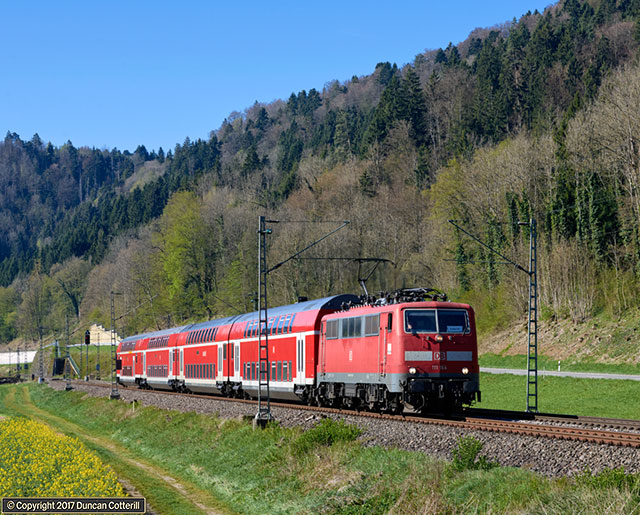
The Old New Order
It’s usually good news for photographers when an older class takes over from more modern traction and the replacement of Class 146.2s with class 111s on most Stuttgart - Singen REs is no exception.111.164 pulled into the loop at Grünholz, between Sulz and Oberndorf, with RE 19032, the 08:18 Singen - Stuttgart RegioExpress service, on Sunday 30 April 2017.
This train is unusual in being worked by a pairing of class 426 and 425 EMUs during the week but is loco hauled at weekends.
Rottweil RE
425.312 rolled south from Sulz (Neckar) towards Grünholz with RE 19087, the 12:18 from Stuttgart to Rottweil, on 30 April 2017.These 4-section articulated units work the 2-hourly Stuttgart - Rottweil REs, detaching a similar unit at Eutingen im Gäu to work to Freudenstadt.
Despite a tight six minute turnaround time at Rottweil and the InterCity services that overtake at Eutingen im Gäu often running late, timekeeping was actually quite good.
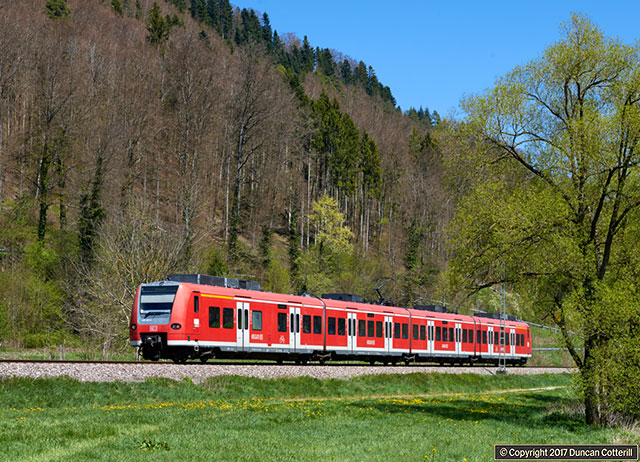
In the hours when no Stuttgart – Singen train runs, there’s a Stuttgart – Rottweil RE (Class 425 EMU) and a Stuttgart – Zürich InterCity. The IC is formed of SBB stock and booked for a Class 101 to Singen, where an SBB Re4/4II takes over. The 425 leaves Stuttgart first, combined with a second unit bound for Freudenstadt. While the two EMUs are splitting at Eutingen the IC overtakes. Five locos are required daily for InterCity duties and, if Stuttgart is short of 101s, it’s not unusual for them to turn out something else for a trip to Singen and back. Most trains observed were worked by the booked 101 but a Class 120 was also seen on the first day of the trip and a 115 worked one of the turns on 5 of the 6 days I was on the line. Unfortunately it was usually 115.509 in it’s ludicrous racing car livery.
Locos seen :
Locos seen :
Locos seen :
- 101.014/100/121/128/129,
- 115.350/509,
- 120.111
Freight Traffic
There isn’t a huge volume of freight on the Gäubahn and what there is has traditionally been worked by a small group of DB Class 185s equipped for operation in Switzerland. This time there was very little traffic, probably due to my visit being over a bank holiday weekend, but more variety of motive power. Only three DB operated freights were seen over the whole period, two hauled by the expected Class 185s and one by a Class 152, the first one I’ve seen on the line. There was also some diesel action in the form of Voith Maxima diesels taking spoil from the Stuttgart 21 excavations to Rottweil, from where it’s tripped to a disposal site at Dießlingen, on the Villingen line. These trains appeared to run on weekday afternoons. The southbounds passed Grünholz, between Sulz and Oberndorf, at 14:06 on the Thurday and at 15:03 and 16:59 on the Friday. I’d left the line at 16:30 on the Thursday so the second train might have run then as well. On both days the first train came back after around 2 hours. I wasn’t around late enough to see the second train return.Locos seen :
- 152.166,
- 185.087/091,
- 263.006[D-MERTZ],
- 264.013[D-MERTZ]
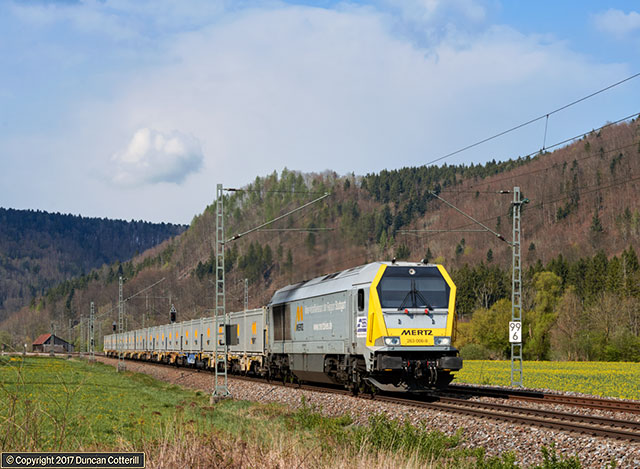
Mertz Maxima
Voith Maxima 30CC 263.006 passed Grünholz with a southbound train of spoil from the Stuttgart 21 excavations to the Dießlingen disposal site on 28 April 2017. Stuttgart 21 is the controversial project to replace the existing Hauptbahnhof with a new underground station.In an age when electric transmission is almost universal for large diesel locomotives, Voith attempted to buck the trend with it’s Maxima design, produced in 3000HP (30CC) and 4000HP (40CC) variants between 2008 and 2010. Large scale orders weren’t forthcoming but the 19 locos built have found employment with various operators.
Photography
The biggest problem was the weather, which was far duller than it should have been at the end of April/beginning of May. There was only half the sunshine I would have expected, with one sunny day and a couple of bright periods on other days. Two of the six days were completely sunless.I concentrated on the scenic section of line in Neckartal, between Horb and Rottweil. Most of the spots I’d used in the first half of the decade were still useable, although some places were getting a bit overgrown. A lot of trees had been cut down at the north end of the section, making the parallel main road and its shiny crash barriers a lot more difficult to hide.
The tree cutting mentioned above appeared to only affect those that had grown on the old trackbed since the line was singled in the 1970s. There’s a project to restore the double track between Horb and Neckarhausen but I’ve seen nothing about doubling further south from Neckarhausen through Sulz and Grünholz to Oberndorf, which is the section that had been cleared. It would make sense as all the booked crossings of passenger trains take place on this section.
The turning of the trains was a blow as it meant I was largely repeating shots I’d done before, albeit with more attractive motive power. If the locos had remained at the south end, it would have opened up a number of locations where it hadn’t been possible to photograph loco hauled DB Regio trains for years. It was still good to photograph 111s on a new line for the class and, thanks to the one sunny day, I did end up with several satisfactory pictures of them.
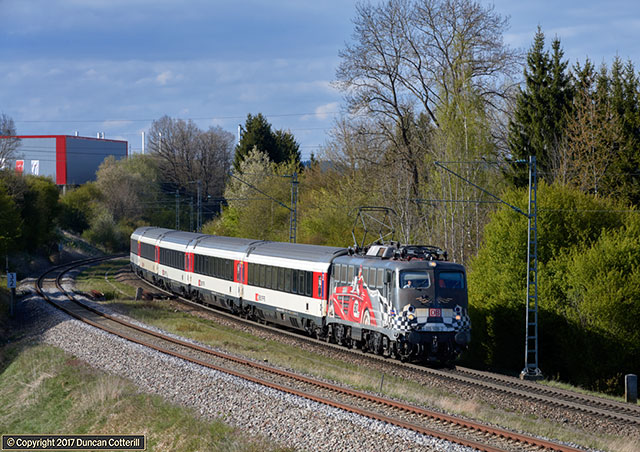
60 Glorious Years
It’s almost unprecedented for a class of locos to remain in express passenger service 60 years after it was introduced but that’s what DB’s Class 115s, better known as 110s or E10s, have achieved. Most were displaced by Class 101s and ICEs by the late 1990s but they never quite disappeared completely and, even in 2017, two different 115s were seen on Stuttgart - Zürich IC services.115.509 accelerated IC 281, the 16:29 from Stuttgart, away from Rottweil on 29 April 2017. It’s just a shame it doesn’t have a more attractive livery.
KBS 750 STUTTGART – ULM (FILSTALBAHN)
02 – 04 and 08 – 10 MayA long overdue visit to this busy and scenic line. I’d only photographed here once before and then only visited one location for a few hours.
The Filstalbahn runs east from Stuttgart along the valley of the Neckar to Plochingen and then follows a tributary, the Fils, to Geislingen, 61km from the start. Here the broad valley ends abruptly at the edge of the Schwäbische Alb, a high plateau that extends 200km north-east from the Black Forest to the Bavarian border. The next 5.7km section to Amstetten involves a climb of 113m, much of it at a gradient of 1 in 44 or 22.5‰. This is the Geislinger Steige, as sharply curved as it is steep, and many freights still take bankers from Geislingen to Amstetten.
East of Amstetten the character of the line changes, as highly populated Filstal gives way to a more open undulating landscape, dotted with farms, clumps of woodland and small villages. After another 15km the line reaches Beimerstetten and the beginning of the 12km descent to Ulm in the valley of the Donau (Danube). The change in elevation is similar to that on the Steige but the gradient is around half that on the other side.
Another 101
Most of the hourly InterCity trains on the Stuttgart - Ulm line are worked by Class 101s on push-pull sets. When freights are few and far between, they’re the only trains around with a loco at the west end of the formation, shame I don’t really like them!101.069 rolled downhill from Beimerstetten towards Westerstetten with IC 2264, the 12:47 from München Hbf to Karlsruhe Hbf, on 10 May 2017.
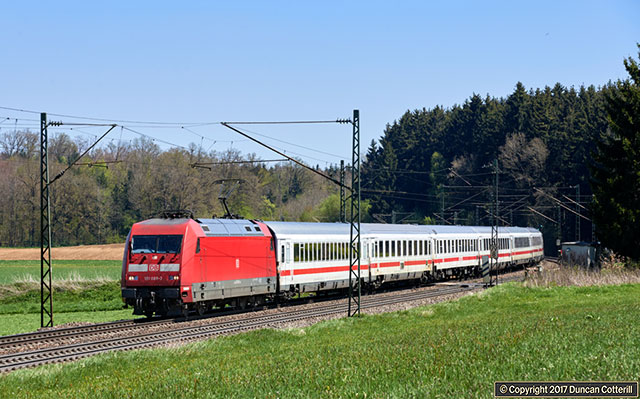
Passenger Services
The Stuttgart – Ulm line sees four passenger trains each way an hour and three of those services are loco worked. There are even more services at the west end but I didn’t spend much time there.InterCity or EuroCity trains run hourly, linking Frankfurt, Karlsruhe and other cities in the west with München. Some services continue to Salzburg, or further into Austria, but most of these were terminating at München during my visit due to engineering works. EC 112 and 113 continued to run as normal, with ÖBB Class 1116 (or occasionally 1016) electrics top’n’tail to cope with the reversals at München and Stuttgart.
Two pairs of IC trains are booked to be worked by pairs of class 218 diesels. IC 2012 and 2013, from and to Oberstdorf, fit into the hourly InterCity pattern but IC 118 and 119 effectively replace a pair of Stuttgart – Lindau IREs. These ran as expected but IC 118 and 119 were noted with a single loco on several occasions. Once a loco had to be sent from Ulm to Stuttgart just so there was something to work IC 119 back.
The other IC or EC services were worked by Class 101s on push-pull sets. Towards the beginning of the trip these trains appeared to face either way at random but by the end all were running with the loco at the Stuttgart end. Only one substitution for a Class 101 was seen when a 120 turned up on a Karlsruhe – München and return. A 120 top’n’tailed with a 101 on another occasion, almost certainly due to a defective driving trailer.
Locos seen :
- 101.007/011/015/017/021/024/025/029/046/053/063/069/073/078/087/103/109/137,
- 120.108/146,
- 218.326/343/434/435 /476/487/491/494/495,
- 1016.023[A-ÖBB],
- 1116.106/134/179/181/186/189/280[A-ÖBB]
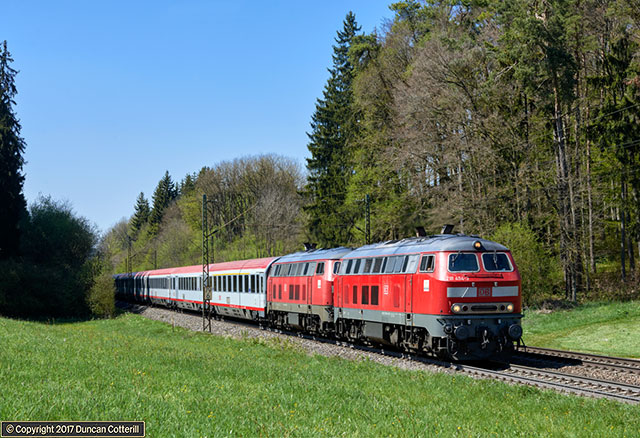
Growling Rabbits
Two pairs of InterCity services are hauled by double-headed Class 218 diesels between Stuttgart and Ulm at the moment, making a nice change from the usual DB Class 101 electrics.218.494 and 218.435 climbed towards the summit at Beimerstetten with IC 119 on 10 May 2017. The 07:27 from Münster Hbf to Innsbruck Hbf is diesel hauled from Stuttgart to Lindau, where an ÖBB Class 1116 takes over for the final stage of the journey. A couple of years ago it also had the honour of being booked for a Class 103 between Münster and Stuttgart.
Rise and Shine
Another long distance train that provides a bit of variety on the Filstalbahn is EC 113, top’n’tailed by ÖBB Class 1116 electrics from Frankfurt to Salzburg.A gleaming 1116.189 started to climb the Geislinger Steige, above the rooftops of Geislingen, with the 08:20 from Frankfurt (M) Hbf to Klagenfurt Hbf, on 10 May 2017. Out of sight at the rear was 1116.181.
Austrian motive power has been a common sight in Germany for many years and ÖBB locos can regularly be seen as far north as Emden and Hamburg.
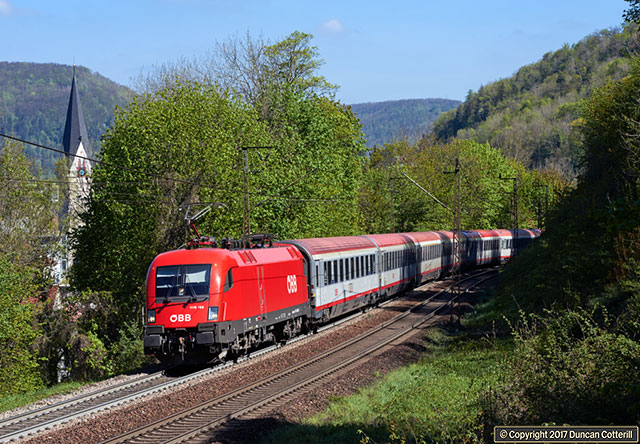
Regional passenger services consist of hourly Stuttgart – Ulm – Lindau IREs and hourly Stuttgart – Ulm RBs, both operated by Class 146.2s on the Ulm end of double-deck push-pull sets. The IREs change to diesel power at Ulm as the line on to Lindau isn’t wired. On a couple of occasions a pair of class 611 DMUs substituted for the booked loco and push-pull set on an IRE but the vast majority ran as expected. The IRE service requires 3 locos each day and the RB service 4 locos.
There are some variations in regional services in the middle of the day to accommodate IC 118 and 119, which run in IRE paths, and probably also to fit better with school finishing times. A couple of the RBs that don’t follow the standard pattern were regularly worked by Class 111s, also at the Ulm end of double-deck push-pull sets; RB 19235, 12:29 Plochingen - Ulm, and RB 19244, 13:40 Ulm – Geislingen. There were also a number of empty stock workings of Class 111s on double-deck push-pull sets that didn’t appear to be associated with any revenue earning workings. The reason for these trains was never ascertained.
Locos seen :
There are some variations in regional services in the middle of the day to accommodate IC 118 and 119, which run in IRE paths, and probably also to fit better with school finishing times. A couple of the RBs that don’t follow the standard pattern were regularly worked by Class 111s, also at the Ulm end of double-deck push-pull sets; RB 19235, 12:29 Plochingen - Ulm, and RB 19244, 13:40 Ulm – Geislingen. There were also a number of empty stock workings of Class 111s on double-deck push-pull sets that didn’t appear to be associated with any revenue earning workings. The reason for these trains was never ascertained.
Locos seen :
- 111.048/073/075/078/082/087/088/091/092/131/135,
- 146.207/208/209/210/211/213/219/220/221/222/223/224
Mystery Movement
111.091 approached Kuchen, between Göppingen and Geislingen, with an eastbound empty stock working on the morning of 10 May 2017.There would be several of these trains on most weekdays, formed of a class 111 on the east end of a double-deck push-pull set, but no obvious reason why the majority, including this one, operated. It added some welcome variety to the usual procession of 101s, 146s and ICEs so I didn’t complain.
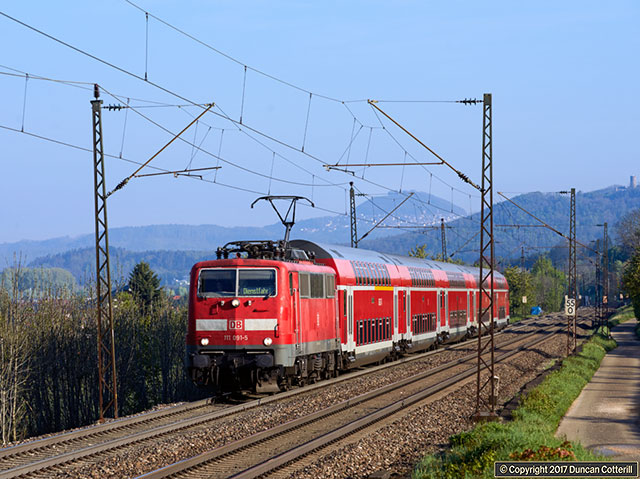
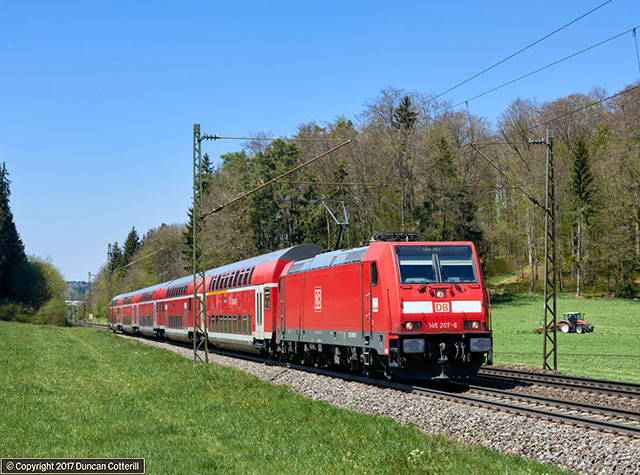
When All Else Fails
146.207 climbed the bank towards Beimerstetten with RB 19235, the 12:29 from Plochingen to Ulm Hbf, on 10 May 2017.When the overhead fell down near Göppingen earlier in the day and everything else stopped running, the RB trains kept going. This one obviously turned round well short of Stuttgart as the loco wasn’t due back for another 90 minutes.
It was around three hours before the ICs and ICEs restarted and another three before everything returned to normal. Of course it had to happen on the one sunny day of the week.
The fourth hourly passenger service is operated by ICEs, with Class 401s on Berlin – München (via Hannover and Frankfurt) services alternating with pairs of Class 403s or 407s on Dortmund – München workings.
Most freights were hauled by DB electrics of classes 145, 152 or 185. As usual, the 185s predominated but it was good to see so many 145s, a class that had largely eluded me until February this year. The older classes 151 and 155 were completely absent apart from the 151s on Geislingen banking duties. A Class 294 was also seen on a pick-up goods at the west end of the line.
Locos seen :
Freight Traffic
The Filstalbahn is the main electrified route linking south-west Germany with the south-east and should be fairly busy for freight, although not in the same league as the Rhein Gorge, Gemünden - Würzburg or the Hannover area. Any alternative route means taking a long diversion to the north so I expected one or two freights each way an hour. In reality, weekday freight flows were nearer to one each way every hour and a half, far fewer trains than I’d expected. The first few days were considerably quieter than the last couple, despite being at the end of the week when things are usually busier, so it might have been engineering work somewhere leading to trains being diverted away. The work that limited the number of IC/EC trains running east of München almost certainly had an impact on traffic headed for Austria via Salzburg or Italy via the Brenner.Most freights were hauled by DB electrics of classes 145, 152 or 185. As usual, the 185s predominated but it was good to see so many 145s, a class that had largely eluded me until February this year. The older classes 151 and 155 were completely absent apart from the 151s on Geislingen banking duties. A Class 294 was also seen on a pick-up goods at the west end of the line.
Locos seen :
- 145.004/009/010/016/020/051/055/057/063/072/074,
- 152.017/054/097/100/120/132/152,
- 185.011/066/067/151/156/161/165/183/189/203/214/237/248/280/361/390/394/398
- 151.041/064/076 (Geislingen Bankers),
- 294.695
Out of Hiding
DB Cargo’s class 145 electrics had done a very effective job of avoiding me until the beginning of this year but turned up in large numbers on the Filstalbahn during this trip, second only to the ubiquitous Class 185s in quantity.145.063 rolled down the Fils Valley between Gingen and Süßen with a mixed freight late on the afternoon of 10 May 2017.
Although the 145s, and 146.2s are very closely related designs, the 145s (and early 146s and 185s) look so much better in DB colours than their ugly younger sisters.
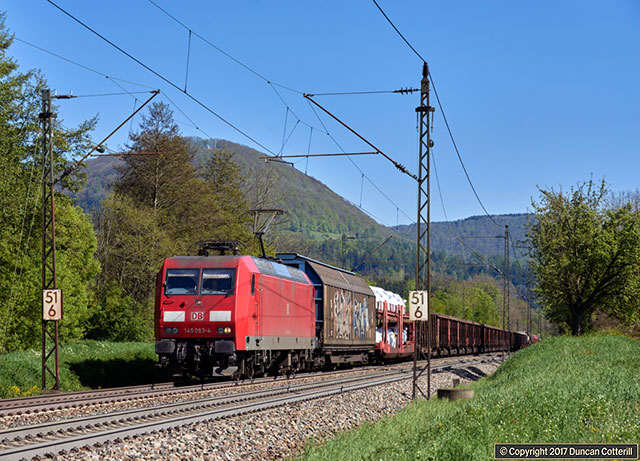
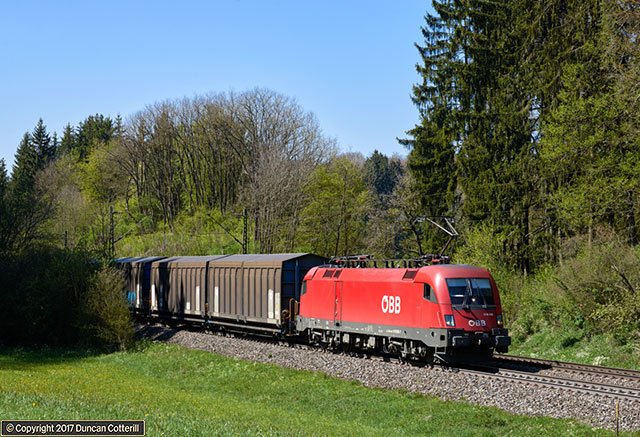
Hotshot to Hungary
ÖBB’s 1116.035 climbed from Westerstetten to Beimerstetten with GA 47151, carrying car parts from Sindelfingen, south-west of Stuttgart, to Kecskemet, in Hungary, for Mercedes-Benz, on 10 May 2017.This was the first freight to run after the overhead collapsed near Göppingen and passed before all the passenger services had restarted, indicating it was probably being treated as a high-priority working.
Independents and foreign operators were very much in evidence, mostly on intermodal and oil trains, and provided a wide variety of traction and liveries. Just over 40% of freight trains were worked by operators other than DB. The most reliable working was a mixed train of containers and vans, conveying car parts from Sindelfingen to Kecskemet in Hungary, and worked by an ÖBB Class 1116. There also seemed to be regular intermodals from the container terminal south of Beimerstetten heading west behind Vectrons in the late afternoon. The most unusual working, seen on two occasions, was a westbound afternoon train of box-wagons, what Americans would call gondolas, hauled by Czech registered ex-DR V100 745.702, formerly 202.661.
Locos seen :
Locos seen :
- 145.086[D-RHC]
- 182.528[D-DISPO]/570[D-DISPO]
- 185.528[D-ATLU]/531[A-TXL]/537[A-TXLA]/594[D-BRLL]/602[D-BRLL]/603[D-RHC]
- 187.073[D-RHC]/077[D-RHC]/308[D-RPOOL]
- 193.244[D-ELOC]/554[D-ATLU]/603[D-DISPO]/824[D-RPOOL]/850[D-DISPO]/861[D-DISPO]
- 266.004[D-RHC]/071[D-HGK]
- 275.870[D-BUVL]
- 745.702[CZ-MTR]
- 1016.037[A-ÖBB],
- 1116.035/064[A-ÖBB]
Rise of the Independents
The proportion of freights worked by independent operators seems to keep increasing and was around 40% during this visit, significantly up on what was seen three years ago. DB Cargo retained a monopoly on mixed freights but intermodal and oil trains were most likely to be in the hands of the independents.RheinCargo’s 145.086 worked a train of oil tanks up Filstal between Gingen and Kuchen on the morning of 10 May 2017.
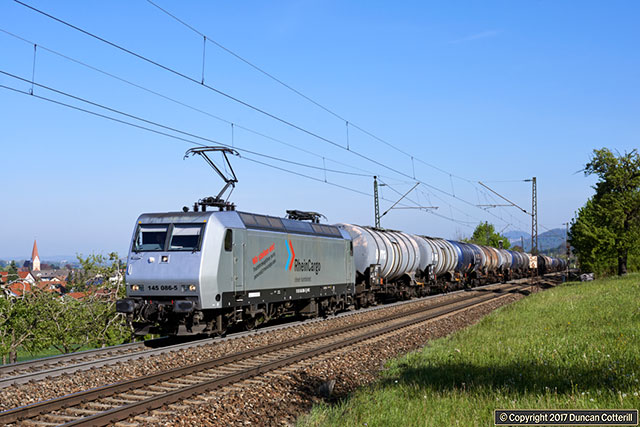
Other Workings
In addition to the passengers and freights there were a number of other workings, including several light engine movements. Most of the light engines featured classes listed above but RailAdventure’s 103.222 also put in an appearance. A DB test train was seen one afternoon, powered by yellow liveried 218.477, and on both Tuesdays 115.293 worked PbZ 2460, a westbound empty stock move, seen near Beimerstetten around 15:30 and Uhingen around 16:30.Working of the Week
The prize has to go to PbZ 2460, the 12:21 Tuesdays only empty stock from München-Pasing Bbf to Frankfurt (M) Hbf, hauled by 115.293 on both occasions that it was seen. This photo was taken west of Uhingen on the afternoon of 2 May 2017, but the same loco was also seen on the same working a week later.The train is one of a number operated by DB Fernverkehr to transfer rolling stock between various depots and workshops all over Germany. These trains are often hauled by Class 115s.
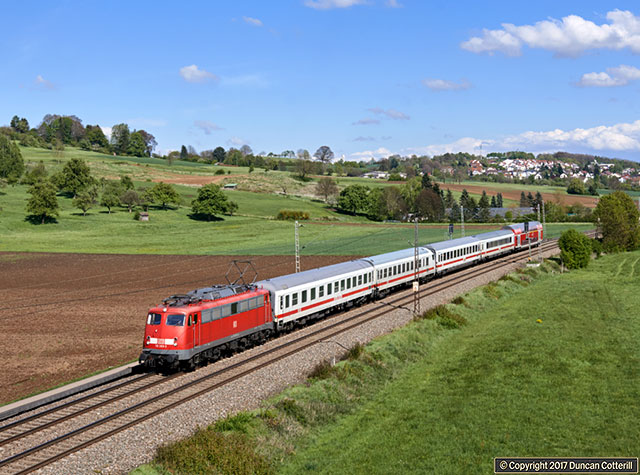
Photography
The Stuttgart end of the line is largely built up with few gaps between villages all the way to Geislingen but I did find a few decent spots on this section. An overbridge around halfway between Ebersbach and Uhingen is good for WB trains in the middle of the afternoon, and positions either side of Gingen were excellent in both the morning (EB) and late afternoon (WB). There are a couple of positions on the Geislinger Steige but it’s mostly overgrown and inaccessible and the shots I found were well on their way to being swamped by the vegetation. From Amstetten across the Schwäbische Alb is more promising but the busy B10 road closely parallels the line to Urspring, limiting the possibilities. The hillsides overlooking the line between Urspring and Lonsee would be good but only very early and very late on a midsummer’s day as they’re on the north side of the line. My favourite spot was a clearing in the woods, around halfway between Westerstetten and Beimerstetten. It’s a long walk from the nearest public road, let alone the nearest station, but the light is good there from lunchtime until late afternoon so the walk is worthwhile. There’s also an early morning shot on the opposite side of the line that would be good in mid-summer.As with the Stuttgart – Singen line, the biggest problem here was the weather, with very little sun on most days. Sometimes it was dry and I could use the time to check out potential positions but there were days when it rained continuously for hours on end and the only sensible thing to do was sit in the car and watch the trains. Actually the sensible thing would have been to give up for the day but I aways waited, just in case it got better.
Wednesday 10 May was forecast to be sunny from start to finish and I’d had plenty of time to plan where I needed to be at what time to get the most out of the day. It all started well enough with a clear blue sky and an early breakfast. The trains behaved themselves for the first three hours or so but around 11:00 everything went quiet. On a line with around 10 trains an hour, you know there’s something wrong when nothing shows up for 40 minutes. Then only the RBs showed up and they were obviously turning round well short of Stuttgart as the locos were coming back much earlier than they should have done. The ICs and ICEs started running after a couple of hours but it was late afternoon before things had returned to some semblance of normality. The disruption was caused by the overhead falling onto the roof of a train east of Göppingen. I wasn’t amused that this had happened on the only sunny day I had on the line.
It was quite a frustrating line to photograph. Most positions are only good for photographing trains in one direction or the other, so that’s five of the ten trains an hour ruled out. One of those five is an ICE, leaving four, and one or two of them will be propelling, leaving two or three. Most of those will be 101s or 146.2s, neither of which are particularly photogenic, leaving only the freights and the 111s really worth getting. When the freights stopped running it didn’t leave a lot to get excited about. Sitting around for ages with nothing happening is frustrating but somehow it’s more annoying when you hear a train coming, get ready to photograph it, then discover it’s not worth a pic. I was shocked to find myself quite pleased when a Class 425 EMU showed up on one of the RBs during the chaos on 10 May but at least it was something different and it wasn’t propelling.
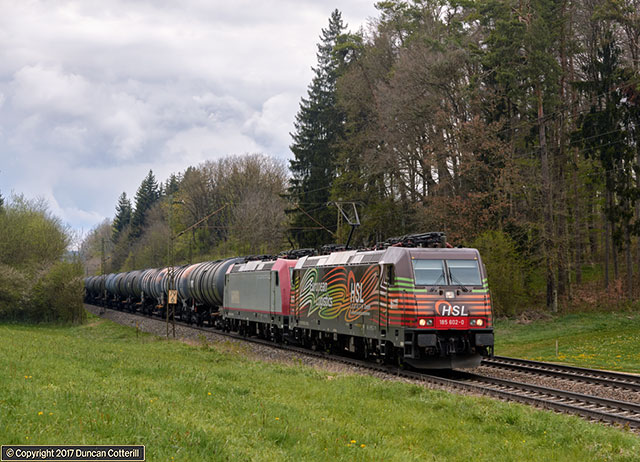
Grim Reality
Eagle eyed readers will have noticed that all but one of the Filstalbahn photos above were taken on the same day. The rest of the time it was usually more like this, with a dull grey sky and barely a hint of brightness anywhere.Beacon Rail registered 185.602 and 185.594 (dit) climbed towards Beimerstetten with an eastbound oil train on 4 May 2017. Both locos are former Crossrail machines and 594 still carries its Crossrail colours without the branding or the grime that usually adorned Crossrail locos. In contrast, 602 now has a snazzy new HSL livery.
KBS 751 ULM – FRIEDRICHSHAFEN (SÜDBAHN)
05, 06, 08 MayUnlike the other two lines, the Südbahn didn’t offer anything new, which was a good reason for another visit. DB’s last classic passenger diesels, the Class 218s, are in rapid decline, after almost 50 years of service, and the Südbahn is now the only place to see them in quantity on a photogenic line. It won’t be long before they’re ousted by new Class 245s, ugly, soulless boxes crammed full of lawnmower engines.
Before The Watershed
218.406 approached Wattenweiler with IRE 4215, the 11:00 Stuttgart Hbf to Lindau Hbf, during a rare sunny break on 6 May 2017.All the way from Ulm, the line has followed the Donau, which flows east to the Black Sea, and its tributary, the Riß. At Wattenweiler it crosses to the valley of the Schussen, which flows into Bodensee then, via the Rhein, into the North Sea.
218.406 had its own watershed moment the following day when it dumped all its transmission oil at Ravensburg.
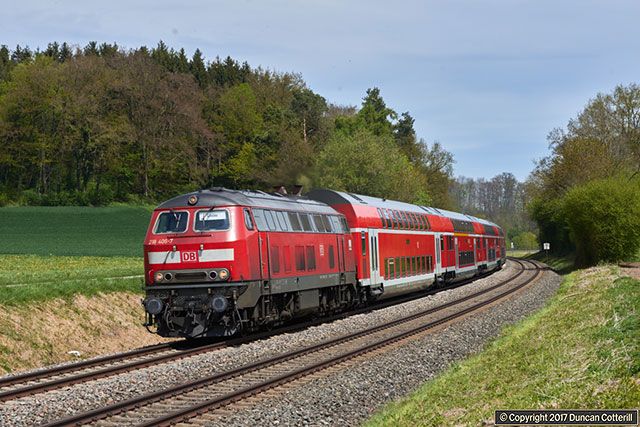
Passenger Services
The main passenger services on the line are hourly IREs linking Ulm, Friedrichshafen and Lindau, formed of 4-coach double-deck push-pull sets powered by a Class 218 diesel. The loco is on the southern end of the set between Ulm and Friedrichshafen, where trains reverse. Four locos are required to cover the service and they generally stuck to diagram all day during my visit, failures excepted. The IREs generally run through from Stuttgart to Lindau, changing from electric to diesel traction at Ulm, which makes them very unusual in being push-pull but also changing engines mid trip.One pair of InterCity passenger trains operates over the line. IC 118 and 119 link Münster, north of Dortmund, with Innsbruck via the Ruhr, Stuttgart, Ulm, Lindau and the Arlberg route. These trains are formed of ÖBB stock and booked for a pair of Class 218s between Stuttgart and Lindau, even though the 94km section from Stuttgart to Ulm is electrified. They run in the path of an IRE service between Stuttgart and Lindau but, not being push-pull, the locos run round at Friedrichshafen.
The 218s probably won’t last too much longer. The first Class 245 has arrived at Ulm and was reported on test a few days before my visit. 245.036 was seen on shed at Ulm on Sunday 7 May but the following day was out working IRE 4209 unassisted. Whether this was a planned introduction to service or a stopgap measure after 218.406 disgraced itself the previous afternoon is unknown. I got the impression that the 218s had availability problems, evidenced by the number of single locos turning up on IC trains, a couple of DMU substitutions on IREs and the 406 incident. If availability is tight then DB will be keen to get the 245s into traffic as soon as possible.
There is also a 2-hourly IRE service from Ulm to Basel, via Friedrichshafen and Singen, worked by pairs of class 611 tilting DMUs. DB DMUs also work stopping passengers, approximately hourly, between Ulm and Biberach, with some continuing to Aulendorf. From Aulendorf to Friedrichshafen stopping services are operated by BOB, no not that BOB, or the Swiss BOB, but the Bodensee Oberschwaben Bahn, which uses pairs of dark blue Class 650 railbuses. There was engineering work between Friedrichshafen and Ravensburg during my visit and the BOB trains were being bustituted on this section, leaving a pair of units to cover the rump service between Aulendorf and Ravensburg.
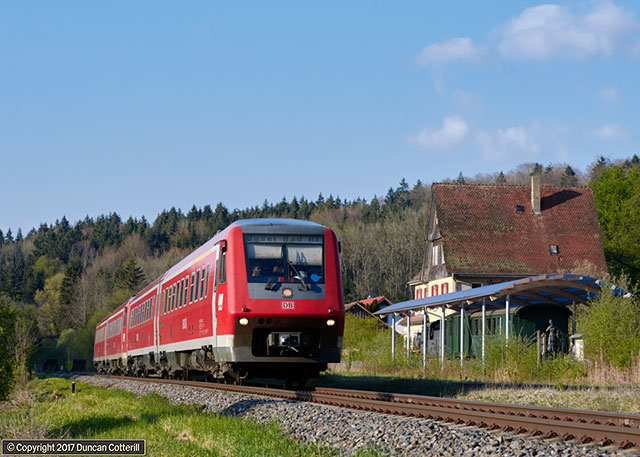
DMU at Durlesbach
Durlesbach station stands in splendid isolation in the middle of the Schussentobel, the remote scenic valley that the line follows south of Aulendorf. The station was closed in 1984 but the building survives, serving as a cafe during peak hiking periods.611.006 and an unidentified companion sped past the station on IRE 3052, the 18:05 Ulm - Basel service, on the evening of 5 May 2017. A Polish narrow-gauge 0-8-0 and two coaches are plinthed next to the station building despite there never having been any narrow gauge here.
Another Nail In The Coffin
Compared to the red Ludmillas that used to work the Roßberg - Friedrichshafen stone train, the white 285 that has taken over left me cold.IGE’s 285.106 led the train south near Durlesbach on 5 May 2017, an uninspiring loco in an uninspiring livery in uninspiring light, yawn.
It’s not only the 218s that are disappearing rapidly, 232s are also heading for extinction and are getting very difficult to find these days.
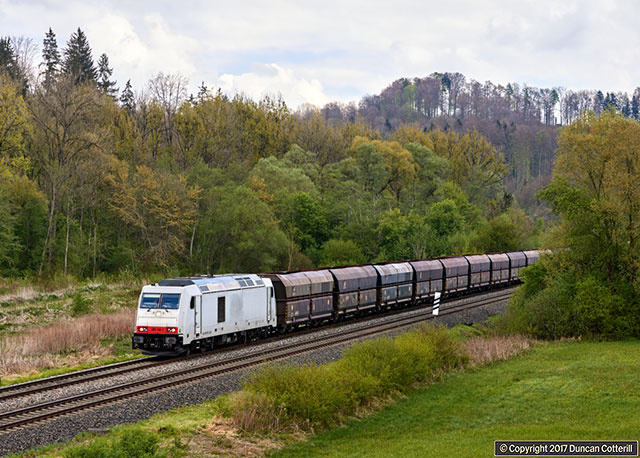
Freight Traffic
There isn’t a lot of freight on this line and only one train was seen while I was there. This was a southbound stone train on Friday 05 May, seen north of Mochenwangen at 12:50 with an IGE 285 on the front. Going back a few years, there used to be a 232 hauled stone train from Roßberg to Friedrichshafen that ran around 60 minutes earlier but DB have probably lost the traffic. It’s unclear whether the train now runs later or it’s just a temporary retiming caused by the single line working south of Ravensburg. There also used to be a 294 worked pick-up goods that went south through Aulendorf around midday and returned in mid afternoon but it didn’t run daily so it was no surprise that I didn’t see it.Photography
The story here was the same as on the other lines, very little decent light. I did get a bit of sun on the Friday afternoon and a little bit more at lunchtime on Saturday but that was all. Again, I was surprised how few of the positions that were used 3 or 4 years ago had become overgrown in the intervening period. Just as well that my visit was as much to enjoy a 218 worked line for what might well be the last time, rather than purely for photography, as I’d have been disappointed with the results.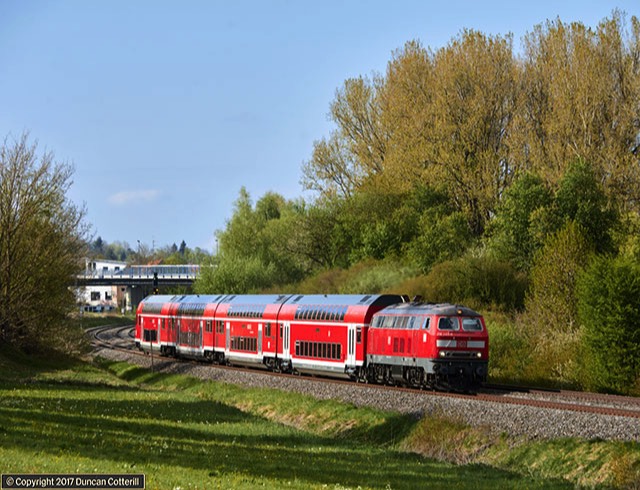
Living On Borrowed Time
218.443 raced away from Aulendorf with IRE 4225, the 16:01 from Stuttgart Hbf to Lindau Hbf, on 5 May 2017.Although I’d visited the Südbahn several times before, it was good to see and hear the 218s in action again.
The first of the Class 245s that will replace the 218s is already at Ulm and was out on normal services a couple of days later. It probably won’t be long before it’s joined by more. It only needs four locos to cover all the IREs so get your rabbits quickly before they’re wiped out by the killer lawnmowers.
A DAY ON THE TRAINS
07 MaySunday 7 May had been forecast to be dull and wet for several days in advance and so it turned out to be. Instead of sitting around hoping the sun might come out, I went for a spin round Württemberg using a Baden-Württemberg ticket. The second class ticket is a very reasonable €23 but first class is only an extra €8, well worth paying as some trains are very crowded in second. My journey started at Aulendorf, heading northwest to Heilbronn via Ulm and Stuttgart, then east to Schwäbisch Hall-Hessental, south-west to Waiblingen via Backnang, east to Aalen, south to Ulm, north-west to Plochingen, south to Tübingen then south-east to Aulendorf via Sigmaringen. A total of almost 720km, first class, for €31, can’t complain about that! Relevant observations from the journey and at other times have been incorporated in the text above or appear below.
OTHER LINES
KBS 757 AALEN – ULM
A very attractive line, particularly at the Aalen end but all trains seen were DMUs. The one I travelled on was a 628 but everything else appeared to be new 644s. There was a large rail connected cement works at Heidenheim-Mergelstetten but no wagons in evidence. Another large factory at Giengen had a rail connection, plenty of vans outside and a container terminal adjacent to the site. There were no indications what might work any freight but it wouldn’t be surprising if DB had lost the traffic to an independent operator.KBS 760 PLOCHINGEN – TÜBINGEN
Quite a few potential locations were noted between Metzingen and Tübingen. I was in a seat with poor visibility until Metzingen so there may be others to the north that weren’t spotted. Most REs appear to be worked by locos at the Tübingen end of double-deck push-pull sets but not enough were seen to get a clear picture of workings. Anything going beyond Tübingen, e.g. Stuttgart – Aulendorf IREs is DMU.KBS 766 TÜBINGEN – SIGMARINGEN - AULENDORF
This line is very scenic, particularly between Balingen and Sigmaringen but all passenger services are DMUs. DB operate 2-hourly IREs from Stuttgart to Aulendorf via Tübingen and Sigmaringen with Class 612 DMUs, some of which have been repainted in Baden-Württemberg white and yellow livery. DB also operate local services between Sigmaringen and Aulendorf with Class 650 single units. Local services between Tübingen and Sigmaringen are operated by HzL, again using Class 650s. There was some evidence of freight traffic along the line with timber being loaded in various places. Mössingen, Storzingen and Mengen all had semaphore signals.New Colours For DB
Several DB Class 612 DMUs have been repainted into Baden Württemberg’s white and yellow colours and look surprisingly good in their new livery, at least while they’re still clean.612.603 was stabled in the sidings next to Aulendorf station on the afternoon of 6 May 2017.
I’d half expected the new Class 147 electrics and Class 245 diesels for DB Regio’s Baden Württemberg operations to carry the new colours but those I saw were in the standard red livery.
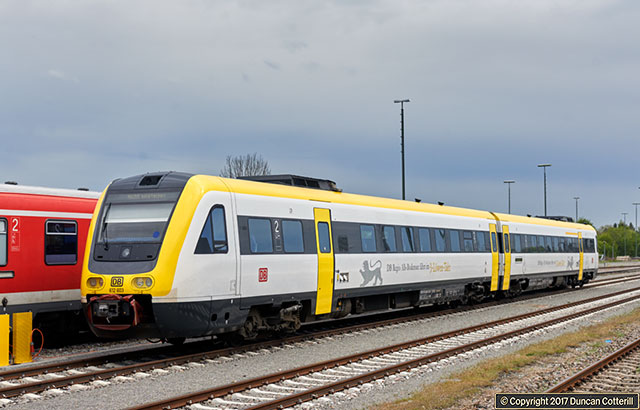
KBS 780 STUTTGART – HEILBRONN
The Heilbronn line follows the Neckar Valley north from Stuttgart. There’s little photographic potential south of Kirchheim and the best spots appear to be north of Lauffen, where the line curves around vine covered hillsides above the river. Most passengers appeared to be loco worked by Classes 111, 112 or 114 on the south end of push-pull sets but one had the loco on the north end.KBS 783 HEILBRONN – SCHWÄBISCH HALL-HESSENTAL
Little photographic potential on this line and the 2-hourly REs appear to be Class 628 DMUs. The line west of Öhringen is electrified and also sees a frequent service of tram-trains.KBS 785 SCHWÄBISCH HALL-HESSENTAL – BACKNANG
This route was on my list of lines to explore once I’d got sufficient sunny shots on the first three. Alas, that didn’t happen so my only visit was a flying one on the Sunday. It does appear to have some photographic potential and possible spots were noted near Wilhelmsglück and Fichtenberg, east of Sulzbach and west of Oppenweiler. Both trains seen were worked by 111s on the west end of push-pull sets but the service is different during the week so that may not apply. Certainly worth a more detailed look.KBS 786 WAIBLINGEN – AALEN
Quite a busy line with hourly REs from Stuttgart to Aalen and 2-hourly Stuttgart – Nürnberg ICs plus some shorter local workings. The REs seen were worked by 111s at the Aalen end of double-deck push-pull sets and the only IC seen had a 120 on the front. The landscape isn’t particularly attractive and few potential photspots were noted, most of which looked possibly OK rather than high priorities for a return visit.KBS 770 STUTTGART – KARLSRUHE
This line wasn’t visited but a Karlsruhe bound IRE was seen leaving Stuttgart behind a brand new Class 147 electric.A Pleasant Surprise
After four full days on the Südbahn, I still didn’t have a single shot of an electric on a freight in sun but 115.293 had passed twice, both times in good light. The old electric rolled downhill from Beimerstetten with on PbZ 2460, the 12:21 Tuesdays only empty stock from München-Pasing Bbf to Frankfurt (M) Hbf, on 9 May 2017.It might have been well into May but it felt more like March and was quite cold when the sun wasn’t out. The trees obviously didn’t think that Spring had arrived yet as very few had come into leaf.
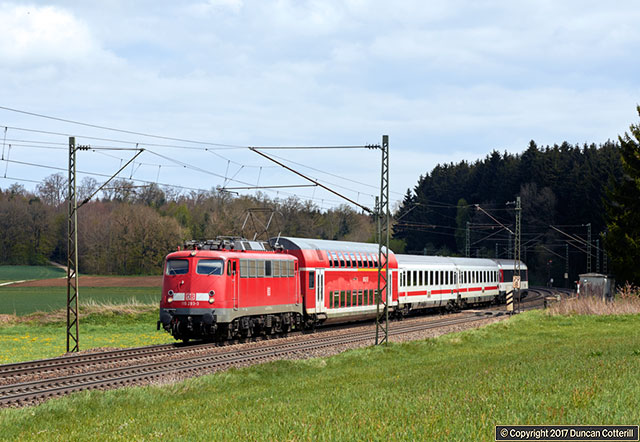
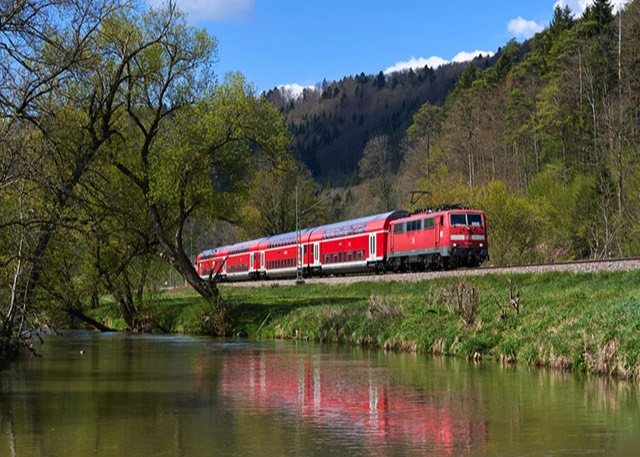
Glorious Neckartal
111.164 headed for Stuttgart with RE 19034, the 10:18 from Singen, on 29 April 2017.The section of line from Rottweil to Horb follows the Neckar and is the most scenic and photogenic part of the route and where I spent the only sunny day of my visit.
This photo was taken a couple of kilometres south of Sulz am Neckar where the line and river run close together. Access is more straightforward than it looks with farm tracks that double as footpaths following the line all the way.
LOGISTICS
I flew from Gatwick to Stuttgart with easyJet on the evening of Wednesday 26 April, returning on the evening of Wednesday 10 May. A hire car from InterRent, booked through Holiday Autos, was used for local travel.Hotels were booked through Booking.com but there rarely seemed to be much of a choice except in the hundreds of euros a night category. Reasonably priced hotels seemed thin on the ground in the areas I was visiting. I cross-checked on Trivago and HRS on a couple of occasions but they were offering a near identical selection. There are actually plenty of hotels in the right areas but they don’t seem to be available on the usual booking sites so a rethink may be required before the next trip.
I ended up using places that were good and not too expensive but usually some distance from the lines I was attempting to photograph, not a problem with a car but more difficult if travelling by train. Breakfasts were all more than satisfactory. The Hotel Krähenbad in Alpirsbach was used when visiting the Gäubahn, the Landhotel Gasthof am Berg in Temmenhausen and the iQ-Hotel in Langenau while on the Filstalbahn and the Hotel Baindter Hof in Baindt when on the Südbahn.
COMMENTS & CONCLUSIONS
After years of being a paradise for fans of loco hauled passenger trains, Germany is starting to get quite difficult, particularly if you’re not keen on the modern classes such as 101s, 146s and 245s. There are enough interesting electrics of classes 111, 112, 114, 120 and 143 around at the moment but nothing like as many as there were a few years ago.It’s the diesels that seem to be under the most immediate threat at the moment with new class 245s making serious inroads into the number of 218s working DB Regio services. Up to now the Südbahn had been unaffected but Ulm recently received its first 245 with another reportedly soon to join it. It won’t be long before the 218s are in the minority and probably only a couple of years before they’ve gone altogether. Don’t expect the interesting electrics to last that much longer than the diesels, new electric locos, EMUs and the loss of business to the independent sector will see to that. Make the most of them while you still can.
Freights were a bit thin on the ground during this trip. I didn’t expect to see too many on the Gäubahn or Südbahn but the lack of traffic during the first few days on the Filstalbahn was a surprise. Things returned to normal during the second week, until the wires fell down on the last day. The variety of traction and liveries continues to increase as the independent sector wins business from DB. the way things are going it won’t be long before independents handle the majority of traffic.
Photographically this trip was one of the most difficult in recent years, almost entirely down to the poor weather. There should be around 6 hours of sunshine a day, on average, in southern Germany in late April / early May but I didn’t even get half that, averaging under 3 hours a day. There were two sunny days, a couple of fairly sunny afternoons and a couple of hours of sun one morning but that was about it for quality light. The other 9 days barely produced a good shot between them. The final kick in the teeth was when most trains stopped running after the wires fell down on the last day, one of the only two sunny days all trip!
Despite the poor weather I did achieve a few of my objectives, getting a number of shots of 111s on the Gäubahn, although they were on the wrong end of the trains. A good number of spots were found on the Filstalbahn and some of them even produced good pictures, those of 115s being particularly satisfying. The rest will have to wait for another trip. The Südbahn produced very little of note and none of the planned exploration of other lines actually happened.
All in all, a fairly poor trip but that just makes me want to go back and try again while there’s still something worth photographing.
Thanks to those who compile the diagrams and those who provided information in response to my e-mails on European Rail Gen, most of which is included in this report. It’s always more interesting to know what you’re photting and why it’s running, particularly when the rain’s lashing down outside, you’ve done all the crosswords and sudokus in the paper, calculated the car’s fuel consumption in litres per hundred kilometres, kilometres per litre, miles per gallon and chains per pint, counted the number of pixels in each of your pictures and are contemplating eating your socks to fend off the boredom.
Freight is the Future
As passenger trains go over to multiple units or new and unappealing locos, freights become a more attractive target for photography. The variety of classes and liveries is much greater and constantly changing, most of the new locos look much better on a long freight than a short rake of Dostos and there’s always a loco on the front of the train. Fortunately Germany has a lot of scenic lines with high volumes of freight traffic.Railpool’s 187.308 brought the trip to a close east of Süßen on the evening of 10 May 2017, heading west with a long train of oil tanks.
